Abstract
Fibroblasts are known to have chemotactic responses to two components of the extracellular matrix, collagen and fibronectin. To extend these observations to other extracellular connective tissue macromolecules and their proteolytic fragments, fibroblasts from adult human skin and from late-gestation (270 d), fetal bovine ligaments were studied for chemotactic responsiveness to tropoelastin and elastin-derived peptides. Bovine ligament tropoelastin and elastin-derived peptides, generated from either human aortic elastin with human neutrophil elastase or from bovine ligament elastin with pancreatic elastase, elicited chemotactic responses that were maximal at 0.2 micrograms/ml (3 X 10(-9) M) and 0.5-2.0 micrograms protein/ml, respectively. Fractionation of the elastin-derived peptides by gel filtration (Bio-Gel P-10) indicated that comparable levels of chemotactic activity were present in all fractions, and amino acid analysis of the fractions showed no relationship between chemotactic activity and desmosine concentration. Taken in conjunction with the observations on tropoelastin, it appears that fibroblast chemotaxis to elastin components does not involve the cross-links of elastin. These results demonstrate that the influences of the connective tissue matrix upon fibroblast migration might include elastin precursors and fragments of elastin.
Full text
PDF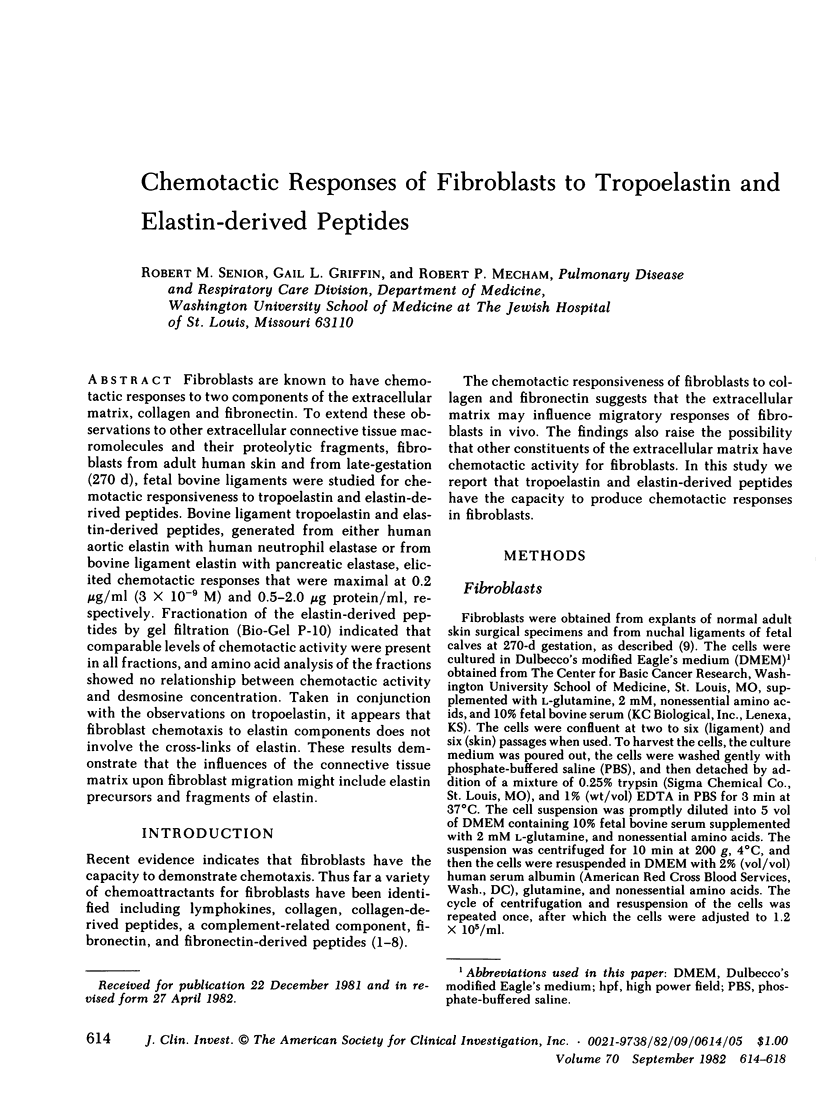
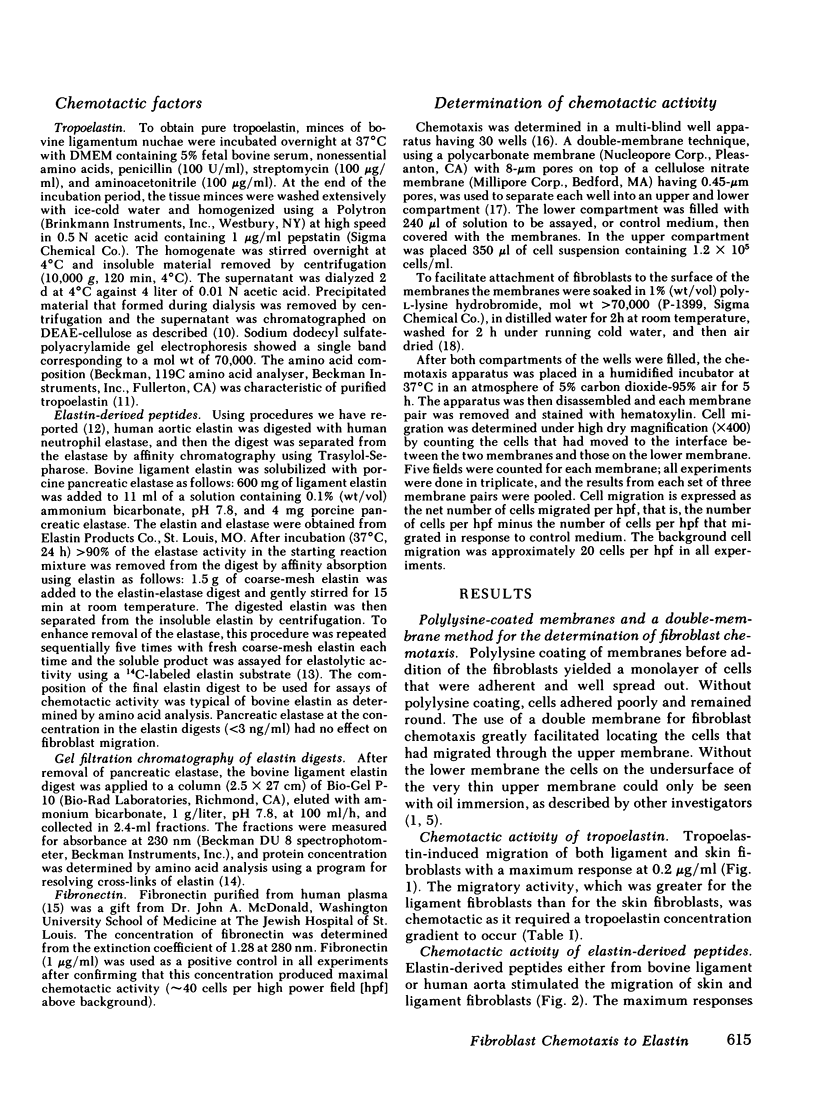
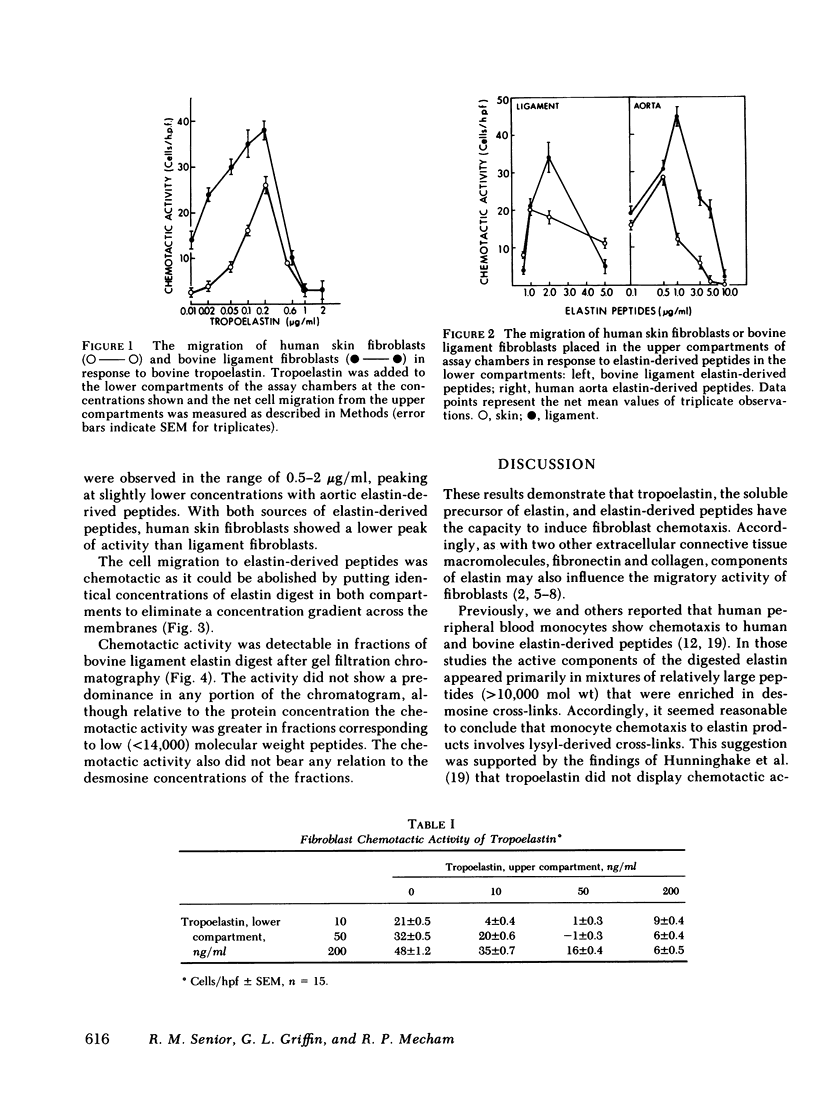
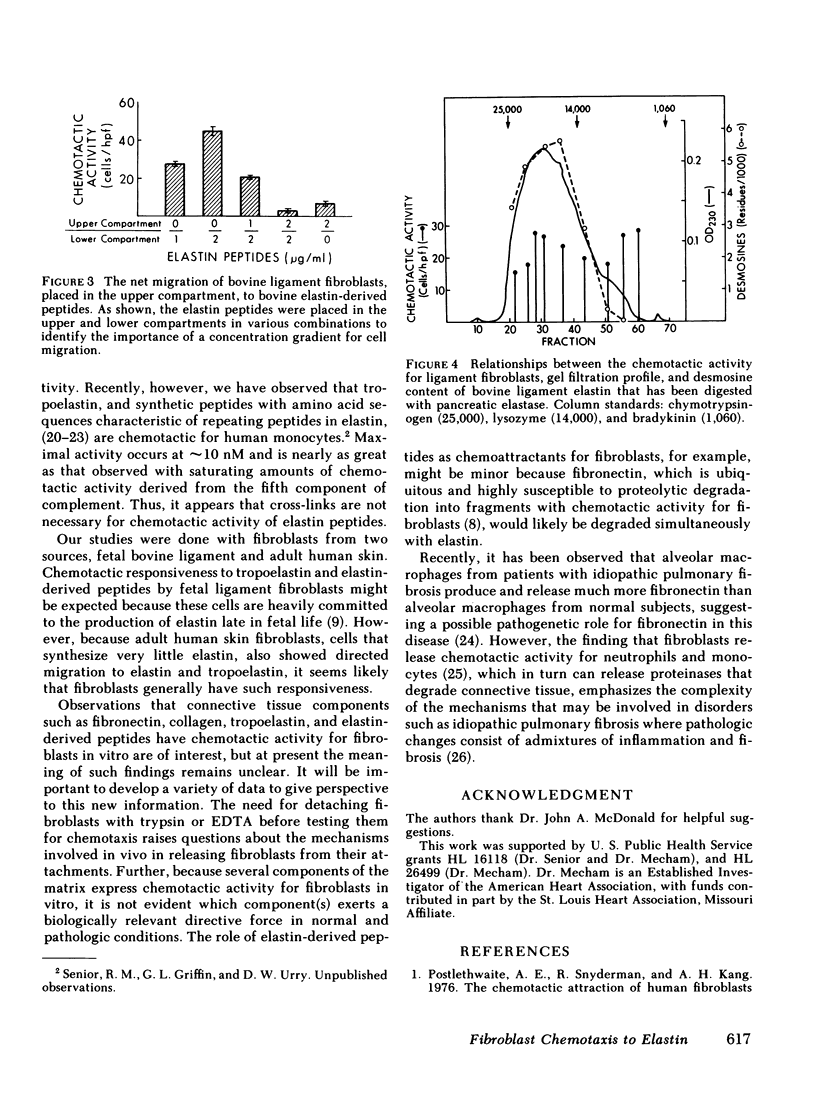
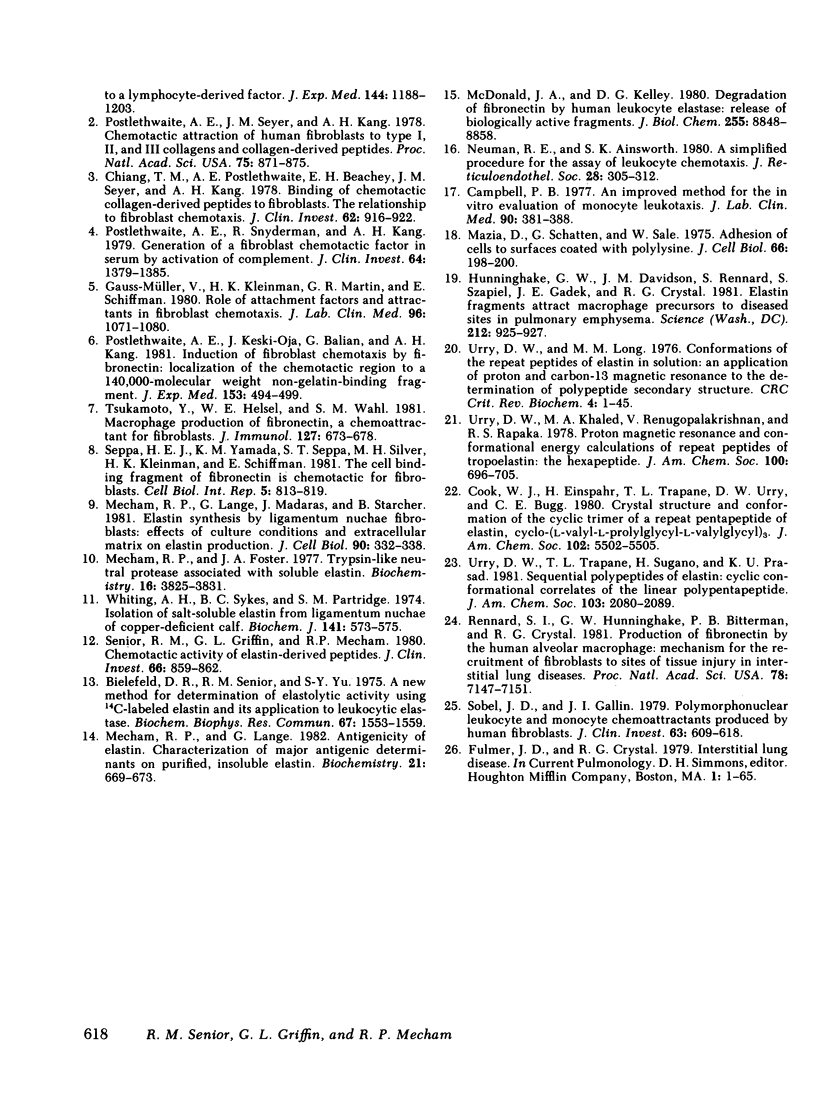
Selected References
These references are in PubMed. This may not be the complete list of references from this article.
- Bielefeld D. R., Senior R. M., Yu S. Y. A new method for determination of elastolytic activity using (14C) labeled elastin and its application to leukocytic elastase. Biochem Biophys Res Commun. 1975 Dec 15;67(4):1553–1559. doi: 10.1016/0006-291x(75)90203-x. [DOI] [PubMed] [Google Scholar]
- Campbell P. B. An improved method for the in vitro evaluation of monocyte leukotaxis. J Lab Clin Med. 1977 Aug;90(2):381–388. [PubMed] [Google Scholar]
- Chiang T. M., Postlethwaite A. E., Beachey E. H., Seyer J. M., Kang A. H. Binding of chemotactic collagen-derived peptides to fibroblasts. The relationship to fibroblast chemotaxis. J Clin Invest. 1978 Nov;62(5):916–922. doi: 10.1172/JCI109219. [DOI] [PMC free article] [PubMed] [Google Scholar]
- Gauss-Müller V., Kleinman H. K., Martin G. R., Schiffmann E. Role of attachment factors and attractants in fibroblast chemotaxis. J Lab Clin Med. 1980 Dec;96(6):1071–1080. [PubMed] [Google Scholar]
- Hunninghake G. W., Davidson J. M., Rennard S., Szapiel S., Gadek J. E., Crystal R. G. Elastin fragments attract macrophage precursors to diseased sites in pulmonary emphysema. Science. 1981 May 22;212(4497):925–927. doi: 10.1126/science.7233186. [DOI] [PubMed] [Google Scholar]
- Mazia D., Schatten G., Sale W. Adhesion of cells to surfaces coated with polylysine. Applications to electron microscopy. J Cell Biol. 1975 Jul;66(1):198–200. doi: 10.1083/jcb.66.1.198. [DOI] [PMC free article] [PubMed] [Google Scholar]
- McDonald J. A., Kelley D. G. Degradation of fibronectin by human leukocyte elastase. Release of biologically active fragments. J Biol Chem. 1980 Sep 25;255(18):8848–8858. [PubMed] [Google Scholar]
- Mecham R. P., Foster J. A. Trypsin-like neutral protease associated with soluble elastin. Biochemistry. 1977 Aug 23;16(17):3825–3831. doi: 10.1021/bi00636a017. [DOI] [PubMed] [Google Scholar]
- Mecham R. P., Lange G. Antigenicity of elastin: characterization of major antigenic determinants on purified insoluble elastin. Biochemistry. 1982 Feb 16;21(4):669–673. doi: 10.1021/bi00533a013. [DOI] [PubMed] [Google Scholar]
- Mecham R. P., Lange G., Madaras J., Starcher B. Elastin synthesis by ligamentum nuchae fibroblasts: effects of culture conditions and extracellular matrix on elastin production. J Cell Biol. 1981 Aug;90(2):332–338. doi: 10.1083/jcb.90.2.332. [DOI] [PMC free article] [PubMed] [Google Scholar]
- Neuman R. E., Ainsworth S. K. A simplified procedure for the assay of leukocyte chemotaxis. J Reticuloendothel Soc. 1980 Oct;28(4):305–312. [PubMed] [Google Scholar]
- Postlethwaite A. E., Keski-Oja J., Balian G., Kang A. H. Induction of fibroblast chemotaxis by fibronectin. Localization of the chemotactic region to a 140,000-molecular weight non-gelatin-binding fragment. J Exp Med. 1981 Feb 1;153(2):494–499. doi: 10.1084/jem.153.2.494. [DOI] [PMC free article] [PubMed] [Google Scholar]
- Postlethwaite A. E., Seyer J. M., Kang A. H. Chemotactic attraction of human fibroblasts to type I, II, and III collagens and collagen-derived peptides. Proc Natl Acad Sci U S A. 1978 Feb;75(2):871–875. doi: 10.1073/pnas.75.2.871. [DOI] [PMC free article] [PubMed] [Google Scholar]
- Postlethwaite A. E., Snyderman R., Kang A. H. Generation of a fibroblast chemotactic factor in serum by activation of complement. J Clin Invest. 1979 Nov;64(5):1379–1385. doi: 10.1172/JCI109595. [DOI] [PMC free article] [PubMed] [Google Scholar]
- Postlethwaite A. E., Snyderman R., Kang A. H. The chemotactic attraction of human fibroblasts to a lymphocyte-derived factor. J Exp Med. 1976 Nov 2;144(5):1188–1203. doi: 10.1084/jem.144.5.1188. [DOI] [PMC free article] [PubMed] [Google Scholar]
- Rennard S. I., Hunninghake G. W., Bitterman P. B., Crystal R. G. Production of fibronectin by the human alveolar macrophage: mechanism for the recruitment of fibroblasts to sites of tissue injury in interstitial lung diseases. Proc Natl Acad Sci U S A. 1981 Nov;78(11):7147–7151. doi: 10.1073/pnas.78.11.7147. [DOI] [PMC free article] [PubMed] [Google Scholar]
- Senior R. M., Griffin G. L., Mecham R. P. Chemotactic activity of elastin-derived peptides. J Clin Invest. 1980 Oct;66(4):859–862. doi: 10.1172/JCI109926. [DOI] [PMC free article] [PubMed] [Google Scholar]
- Seppä H. E., Yamada K. M., Seppä S. T., Silver M. H., Kleinman H. K., Schiffmann E. The cell binding fragment of fibronectin is chemotactic for fibroblasts. Cell Biol Int Rep. 1981 Aug;5(8):813–819. doi: 10.1016/0309-1651(81)90253-8. [DOI] [PubMed] [Google Scholar]
- Sobel J. D., Gallin J. I. Polymorphonuclear leukocyte and monocyte chemoattractants produced by human fibroblasts. J Clin Invest. 1979 Apr;63(4):609–618. doi: 10.1172/JCI109343. [DOI] [PMC free article] [PubMed] [Google Scholar]
- Tsukamoto Y., Helsel W. E., Wahl S. M. Macrophage production of fibronectin, a chemoattractant for fibroblasts. J Immunol. 1981 Aug;127(2):673–678. [PubMed] [Google Scholar]
- Urry D. W., Long M. M. Conformations of the repeat peptides of elastin in solution: an application of proton and carbon-13 magnetic resonance to the determination of polypeptide secondary structure. CRC Crit Rev Biochem. 1976 Jun;4(1):1–45. doi: 10.3109/10409237609102557. [DOI] [PubMed] [Google Scholar]
- Whiting A. H., Sykes B. C., Partridge S. M. Isolation of salt-soluble elastin from ligamentum nuchae of copper-deficient calf. Biochem J. 1974 Aug;141(2):573–575. doi: 10.1042/bj1410573. [DOI] [PMC free article] [PubMed] [Google Scholar]


